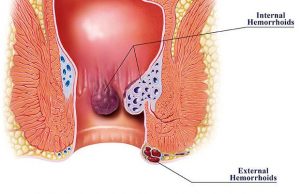Hemorrhoids – Symptoms – Treatment
Hemorrhoids are a normal part of our body. Hemorrhoids (HEM-uh-roids), also called piles, are a type of vein located in our anus and lower rectum, similar to varicose veins. Hemorrhoids can develop inside the rectum (internal hemorrhoids) or under the skin around the anus (external hemorrhoids). They are neither veins nor arteries but an intermediate vascular mass with special functional properties. Their role is to protect us from leakage. Hemorrhoids, in other words, seal the intestine at the anus.
When the hemorrhoids become swollen and deformed, that’s when we say we have hemorrhoidal disease. The pathology of hemorrhoids has two main elements: swelling and prolapse (hemorrhoidal tissue coming from the inside that can often be felt on the outside of the anus when wiping or having a bowel movement).
What causes them to happen?
The cause remains unknown, although 3 out of 5 now have or are about to develop hemorrhoidal disease. Factors that are implicated, however, include the following:
1. Chronic constipation 2. Pregnancy/childbirth 3. Heavy work that contributes to the frequent increase in intra-abdominal pressure 4. Inherited predisposition 5. Habitual life and obesity 6. Prolonged standing 7. Poor hygiene of the anal area and poor toilet habits. More
Why shouldn’t we remove them?
Hemorrhoids should not be removed 1) because their absence creates very unpleasant complications such as leakage of fluids from the bowel and unintentional release of gases, 2) because the removal of hemorrhoids is accompanied by incredibly unbearable pain. Removing them, especially if they are inflated and with high prolapse, becomes very dangerous.
Are hemorrhoids completely curable?
Yes, hemorrhoids σat however advanced stage they are, can be fully treated with the proper technique, which requires the use of a laser, training and experience. The result is permanent and without complications.
More
How can we treat them?
The best, the most modern and the most effective method for treating hemorrhoids is laser hemorrhoidoplasty, since it achieves the most gentle and point-targeted surgery, leaving the anal sphincter and the intestinal mucosa intact. For advanced hemorrhoidal disease, the combination of laser with simple ligation-suspension is the safest and most effective method.
What is laser hemorrhoidoplasty?
Laser hemorrhoedoplasty is the most modern and safest procedure for the treatment of hemorrhoids. It is painless and bloodless, lasts only 15 minutes, and achieves a definitive result without complications. The patient returns home on the same day and to his activities from the very next day.
Is it possible to prevent hemorrhoids?
By making sure we have good and timely stools with soft feces and without pressure to empty the gut, we can prevent the appearance of hemorrhoids. Exercise, walking and eating a high-fiber diet helps reduce constipation, softening stools and facilitating their elimination. The short residence time in the toilet (5 to 10 minutes) and the washing with lukewarm water after defecation contribute significantly to the prevention of hemorrhoid disease.



